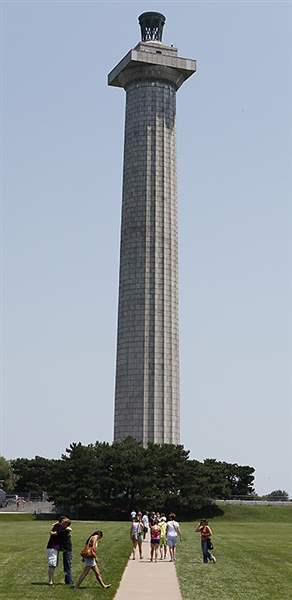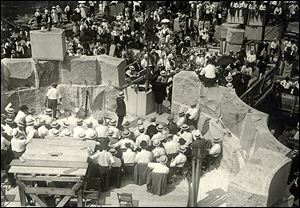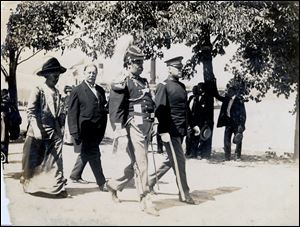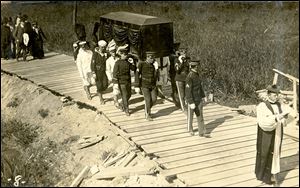
WAR OF 1812 CENTENNIAL
Perry monument re-enactment to honor builders
Masons return to Put-in-Bay for rededication ceremony
7/4/2013
Perry’s Victory and International Peace Memorial was closed three years for repairs.
THE BLADE
Buy This Image

Some 5,000 Masons dedicated the Perry monument cornerstone during a July 4, 1913, ceremony.

Perry’s Victory and International Peace Memorial was closed three years for repairs.
PUT-IN-BAY, Ohio — A century ago, 5,000 Masons traveled to Put-in-Bay to lay the cornerstone of a monument that still stands as a towering symbol of South Bass Island and the War of 1812.
Today, an estimated 2,000 Masons are expected to participate in a re-enactment of that cornerstone ceremony at Perry’s Victory and International Peace Memorial.
The event is one part of Put-in-Bay’s Fourth of July celebrations featuring a parade, concert, naturalization ceremony, fireworks, and other activities.
“It’s always great to be part of a historic event, and that is what this is. The centennial is ... very meaningful,” said Jim Adkins, the Masonic representative from Norton, Ohio, who serves on a committee organizing the events.
Stretching 352 feet skyward, the Doric column made of pink Milford granite from Massachusetts took about three years to build and was finished in 1915. It commemorates the September, 1813, victory of Commodore Oliver Hazard Perry at the Battle of Lake Erie over the British — a key point in the War of 1812.
The effort to build the memorial was spearheaded by a commission with representatives from nine states including Ohio and Rhode Island, where Commodore Perry was born. Each state had a connection to the war, such as sending a regiment to fight, said Maggie Beckford, president of the Lake Erie Islands Historical Society and executive director of the Put-in-Bay Chamber of Commerce.
Masons, who conduct cornerstone dedication ceremonies for monuments and government buildings across the nation, boarded steamboats for the July 4, 1913, ceremony at Put-in-Bay, Mr. Adkins said. Members of the organization will return for a re-enactment of that ceremony at 3 p.m. today, following a procession in a 2 p.m. parade through the Ottawa County village.
Participating Masons hail both from the states involved in the monument’s creation and Canada, Mr. Adkins said.
Another stone was cut from the same quarry that produced the original blocks used to build the memorial for the occasion. It has been engraved with the dates of the first ceremony and today’s re-enactment and will be given to the National Park Service. Grand Master James Easterling, Jr., of the Grand Lodge of Free and Accepted Masons of Ohio, in Springfield, will conduct the ceremony.
The memorial was the site of another large ceremony in September, 1913, when the remains of three American and three British officers were taken to the memorial to be buried beneath the rotunda floor. The officers, killed during the battle, had been buried near the shore in Put-in-Bay.
The region has major bicentennial celebrations of the Battle of Lake Erie planned this summer, including a Labor Day battle re-enactment.

William Howard Taft, in suit, by then a former president, attended the September, 1913, dedication ceremony when the remains of three American and three British officers were buried beneath the rotunda floor.
The memorial has been part of the park service since 1936.
The park service estimates the column weighs 36.8 million pounds, and stretches 47 feet higher than the Statue of Liberty. On a clear day, visitors to the observation gallery can see the Lake Erie islands, the mainland of Ohio, and as far away as Detroit, according to the National Park Service.
Various sources estimate the project’s cost at the time it was built to be between $600,000 and $1 million. Funding came from private donations as well as contributions from the federal government and states participating in the commission, said Nichole Fifer of the National Park Service. Ohio gave about $126,000, according to historical accounts.
Ms. Fifer estimated a couple hundred people were involved in the construction, including Freemason stone workers who expertly chiseled the unique stones.
“No two are the same in terms of size and dimension,” she said.
The monument suffered some damage in 2006 when a piece of the fascia stone dropped to the ground. The crashing rock injured no one but resulted in the site’s temporary closure.

The remains of three American and three British officers were taken to the memorial in September, 1913, to be buried beneath the rotunda floor.
Reconstruction work closed the building from 2009 until July, 2012, Ms. Fifer said.
The column is a burial place, a symbol of peace among the United States, Great Britain, and Canada, and a big tourist attraction, Ms. Beckford said. The island’s roughly 500 hotel rooms, which include cottages and other rental accommodations, were booked for the nights of July 3 and 4, she said.
“It’s just an amazing structure that they would have put together back then,” she said of the monument. “We’d like to see it stand here another 100 years.”
Contact Vanessa McCray at: vmccray@theblade.com, or 419-724-6065, or on Twitter @vanmccray.